Native prairie garden replaces half the lawn in the Grosz Garden
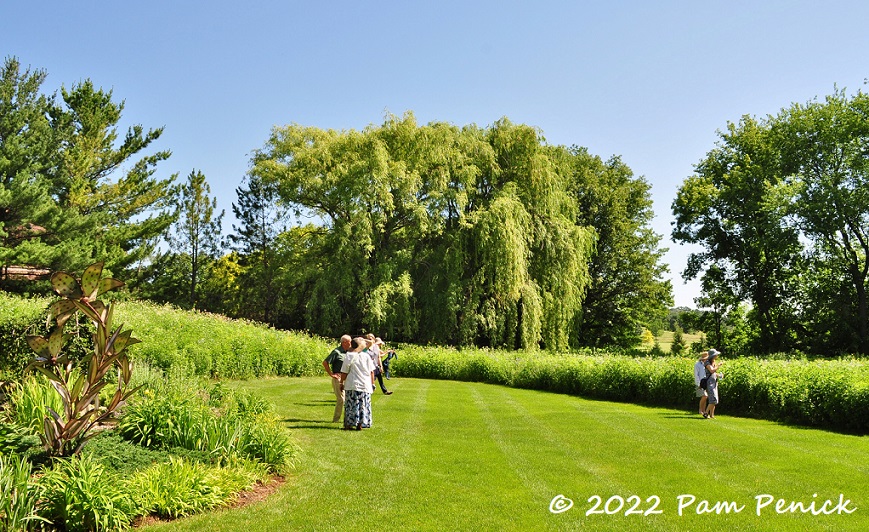
A shoulder-high, prairie-style garden makes a graceful swoosh through the sunny backyard of Linda and Phil Grosz in Middleton, Wisconsin. As the second stop on the Madison Garden Bloggers Fling tour in June, it immediately grounded me in the Upper Midwest, land of the tallgrass prairie.
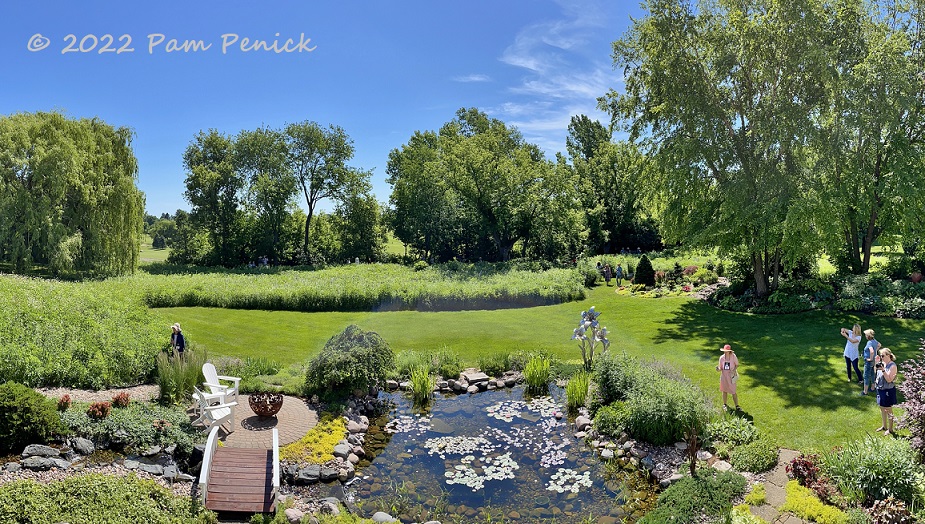
Linda and Phil built their house 25 years ago. Back then, says Linda, “the only vegetation on the lot was weeds and a row of old box elders.” Today a large pond and the prairie garden take up most of the expansive backyard — a space most people would unthinkingly carpet with lawn.
Linda had other ideas. “I’d lived in Los Angeles for 20 years before relocating back to Wisconsin and wasn’t much of a gardener at that time….I wasn’t sure what to do with all that land, but I knew I didn’t want just a big, boring, lawn. I perused gardening books to get some ideas and had a eureka moment when I came a across a picture of a colorful wildflower meadow. I then got a referral to Neil Diboll at Prairie Nursery, who helped us to realize the vision of a backyard prairie….Neil designed a custom seed mix that was appropriate for our heavy clay soil, with additional species added for moister, shadier areas. He also specified the ‘no-mow’ fescue paths that wrap around the back and sides of the prairie planting.”
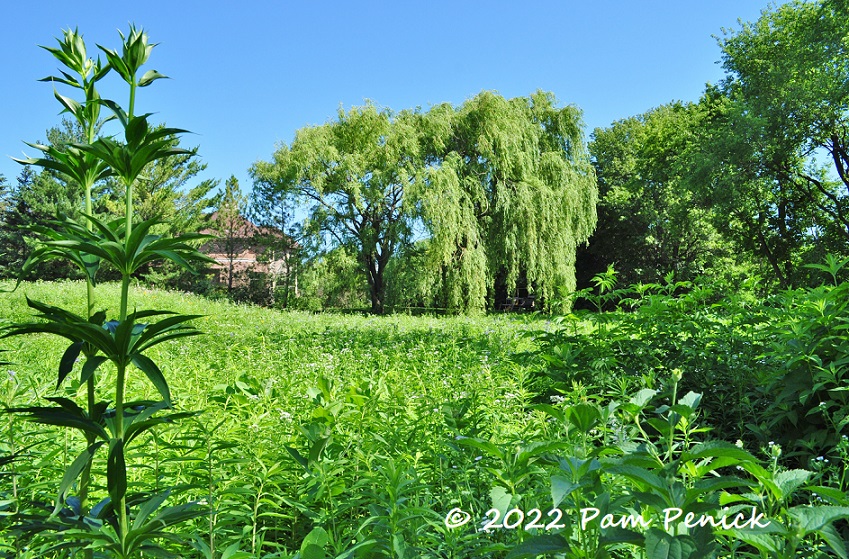
Although the garden is located within a neighborhood (albeit with homes spaced far apart) and backs up to a golf course, it feels private thanks to willows and other large trees and shrubs around the perimeter. This also keeps the center sunny and open, which prairie plants prefer.
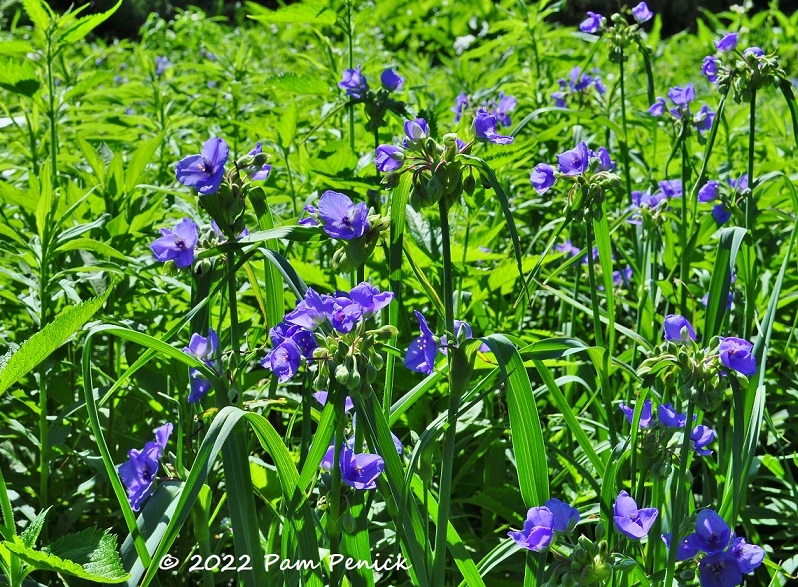
June was still early for a Wisconsin native prairie garden, and while it was tall and lush with sprinklings of flowers, the main show would come later. “The planting is composed of 100% native plants,” says Linda. “When the Fling visited, the most prominent plants were tradescantia (spiderwort), golden alexanders, penstemon and baptisia (indigo). Later in summer it is more colorful, with ox-eye sunflower, orange butterfly weed, purple coneflowers, lavender monarda, and my favorite Turk’s cap lilies, among the many plants that are in bloom. Fall bloomers include several types of asters as well as rudbeckia.”
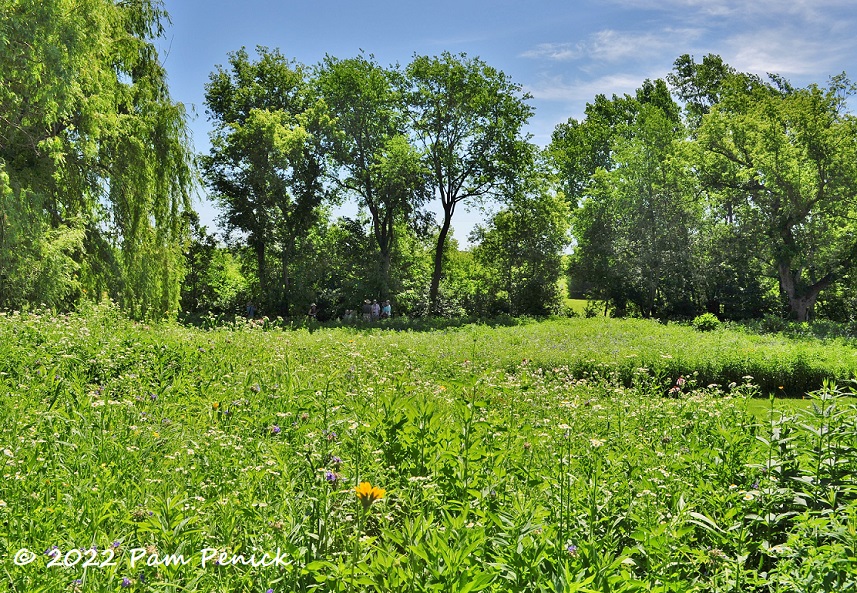
I didn’t see many grasses coming up among the wildflowers — grasses are such a big part of Blackland Prairie-style gardens here in Texas — and I asked Linda about it. “There are some native grasses that show up in late summer and fall (including Indian grass, big bluestem, little bluestem, and switchgrass) as well as a bit of fox sedge along the moister, shadier edges. But our prairie is dominated by forbs (perennial wildflowers). It is quite beautiful and colorful, but a larger percent of grasses would allow for better controlled burns and also help suppress weeds. The original planting mix from Prairie Nursery included plenty of grass seeds, but while the forbs thrived and grew abundantly in our clay soil, the grasses did not. I’ve tried adding more grass seed over the years, with limited success, as the tall forbs often shade out the grass seedlings.”
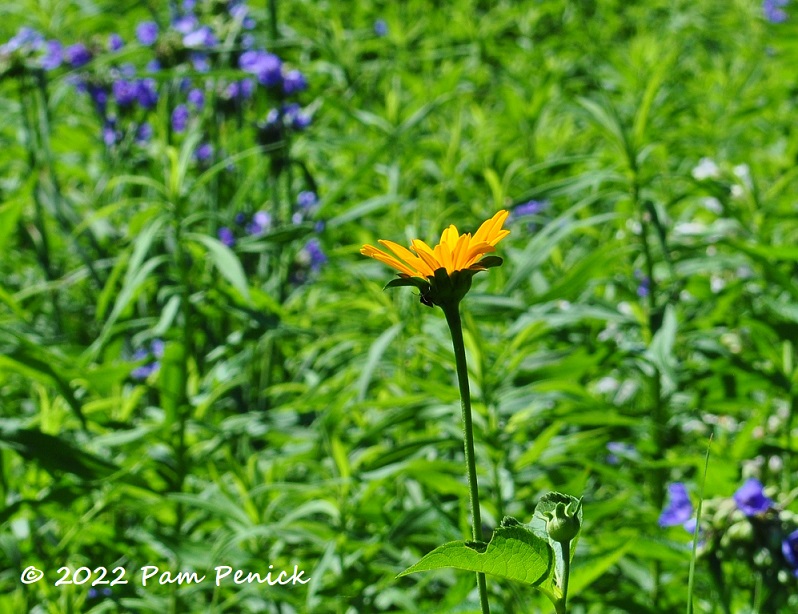
I would love to see this garden at its peak bloom, but even in early summer it was pretty, with early flowers catching the sunlight amid the greenery. Linda says the prairie garden requires no watering or fertilizing, but weeding is essential. “In the early years, my husband and I did all the weeding, carefully combing the prairie for Canada thistle, prairie dock, and other perennial weeds to pull, or cutting down biennial invasives such as Queen Anne’s lace. I still do some weeding, but I now have help from Good Oak Ecological Services in controlling weeds and aggressive native species, such as Canada goldenrod and cup plant. Good Oaks also does controlled burns for us every three or four years. In other years, our lawn service mows the prairie once in early spring with a sickle bar mower.”
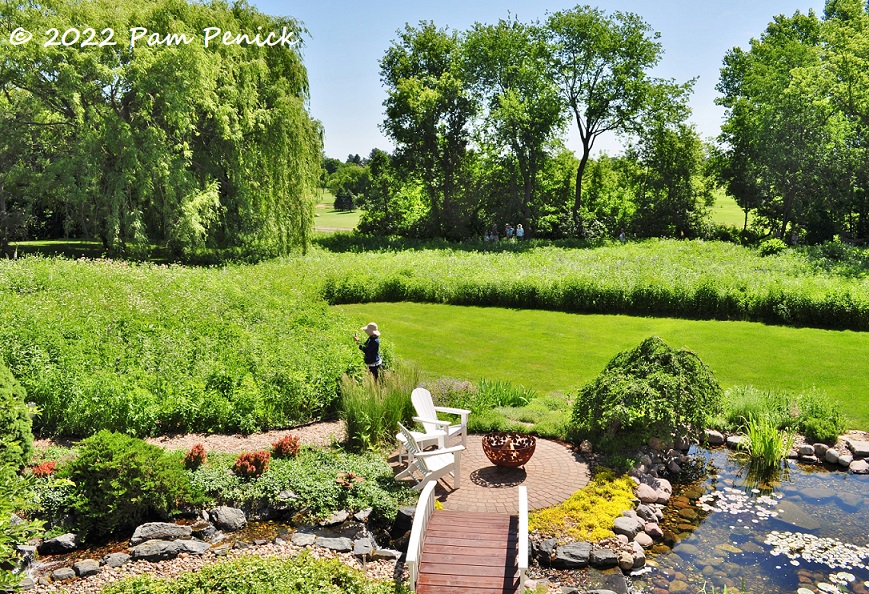
With the native prairie plants, pond, and tree cover providing habitat for all kinds of birds, insect pollinators, and other species, Linda enjoys wildlife-watching as much as the beauty of the plants and changing of the seasons. “The prairie provides year-round beauty, but my biggest joy is seeing all the birds, butterflies, bees, and other pollinators sustained by the native plants,” she says.
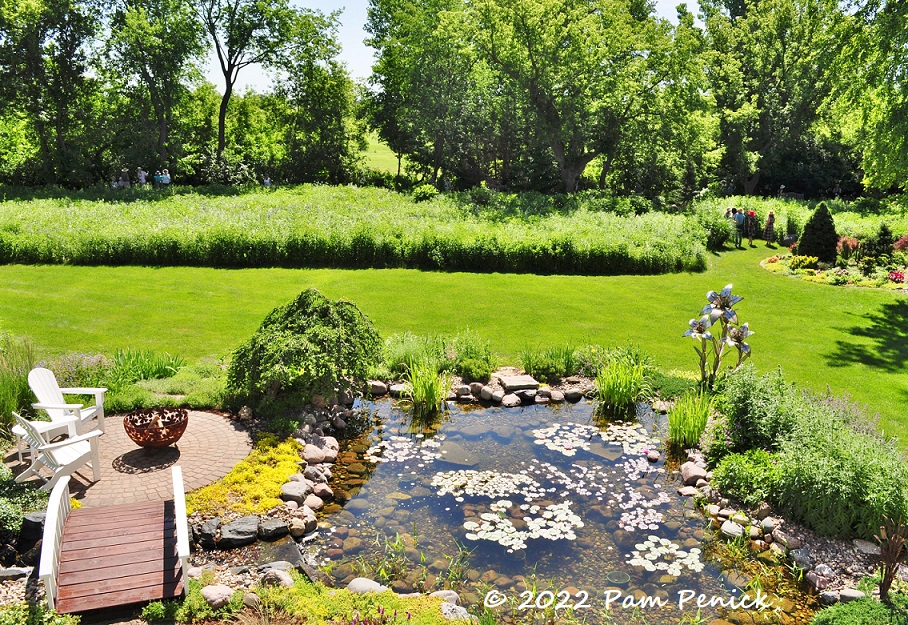
A convert to native-plant gardening, Linda adds, “I would definitely encourage others to replace lawn with a native prairie planting or simply incorporate more natives into their home landscapes. As long as you select species that are right for your soil type — in my instance, very heavy clay — native plants are quite easy to grow. There are myriad benefits including eliminating the need for watering, fertilizing, and weekly mowing. The deep root system absorbs and filters water run-off and also sequesters carbon.”
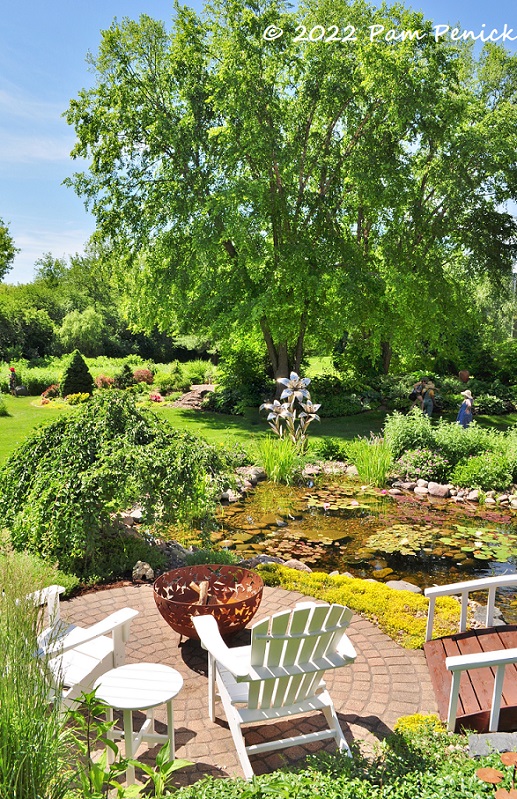
And now let’s explore the other features of the garden, including the waterlily pond right off the back of the house, overlooked by a circular patio for two, with a firepit for chilly evenings.
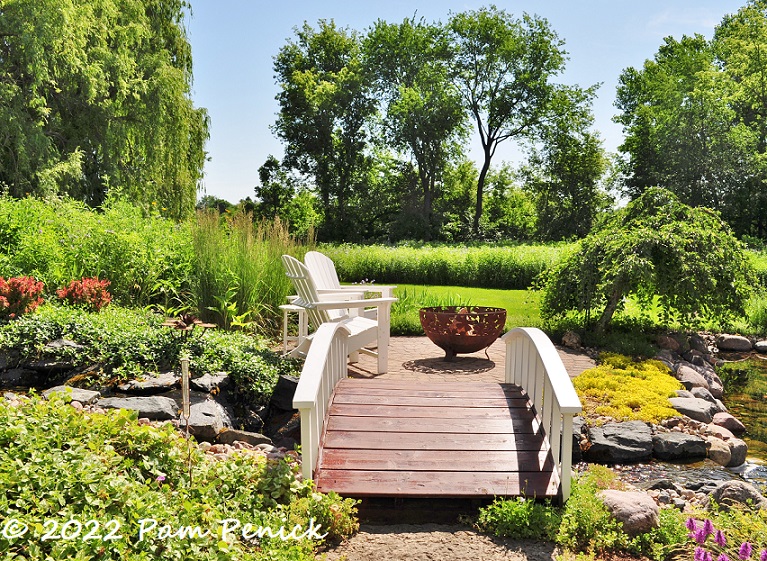
A wooden bridge leads to the patio, arching over a stream that flows into the pond.
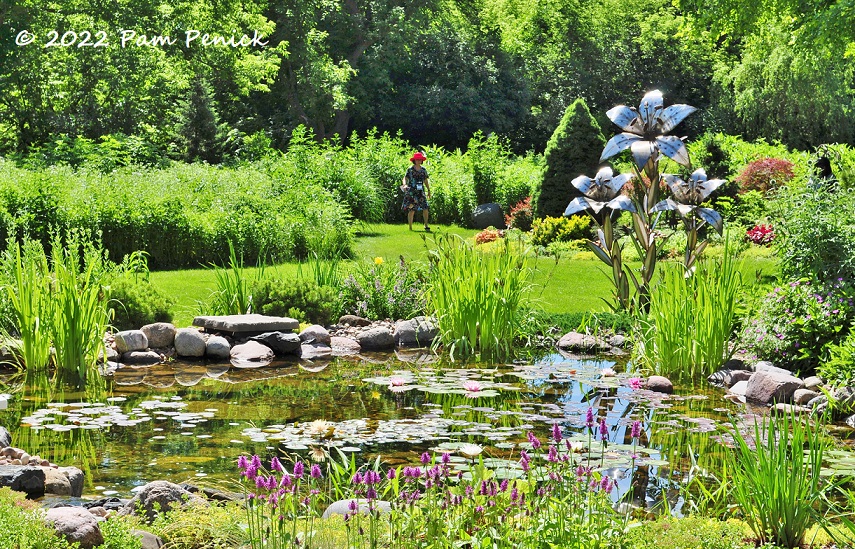
This must be a paradise for birds. For the owners too. I enjoyed their giant flower sculpture as a focal point at one end of the pond.
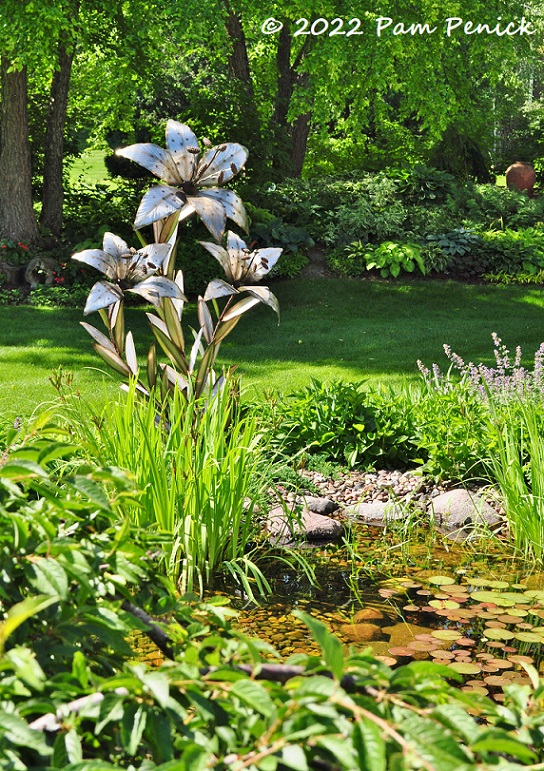
Daylily sculpture
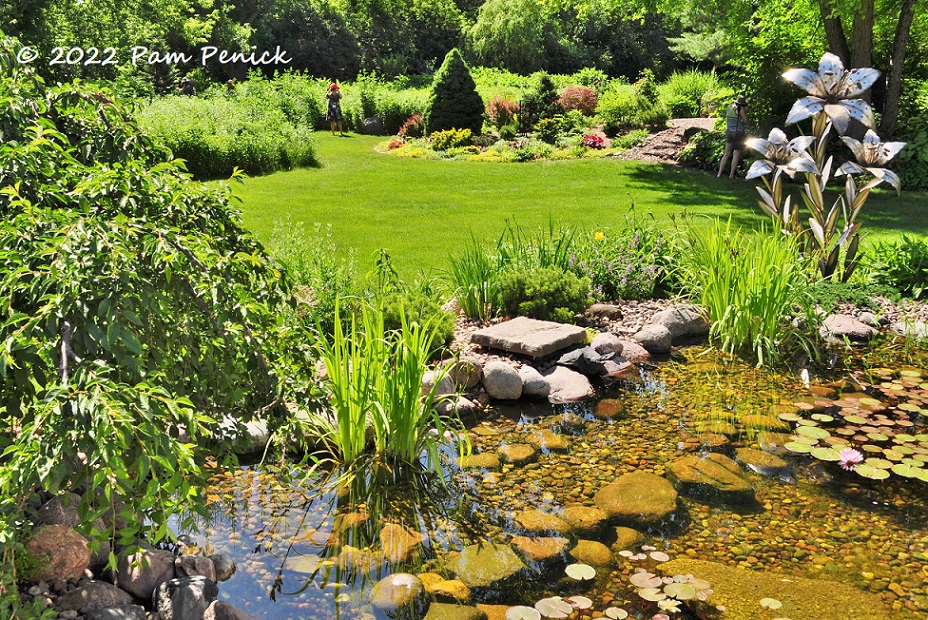
Another view
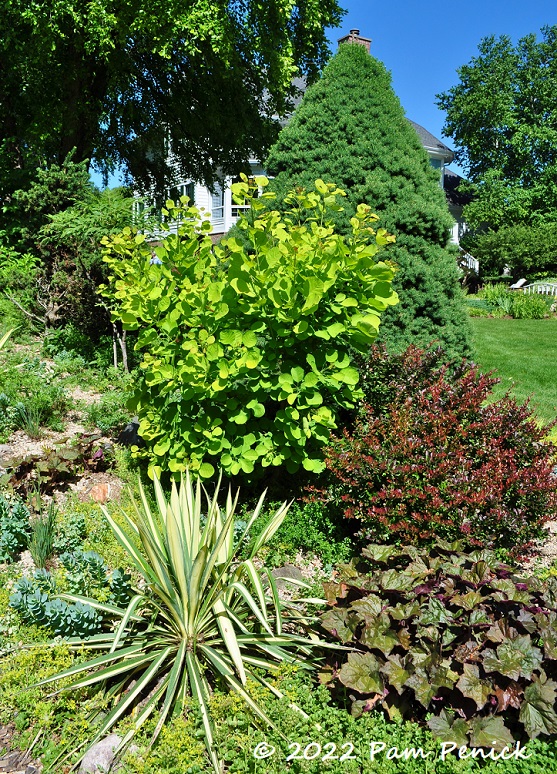
Along one border, other sun lovers — even a yucca! — make a pretty combo of contrasting foliage color and form.
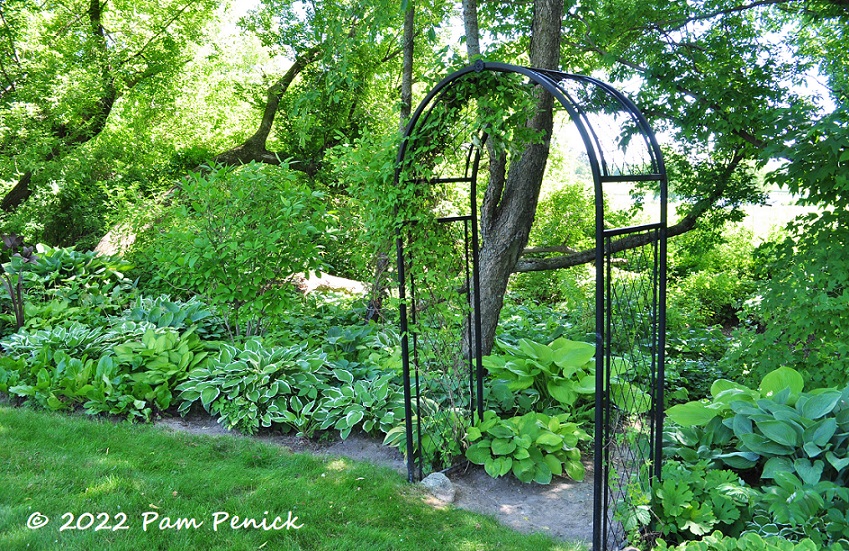
At the back of the property, a shade garden offers a vision of cool greenery. Beyond the arch lies the adjacent golf course.
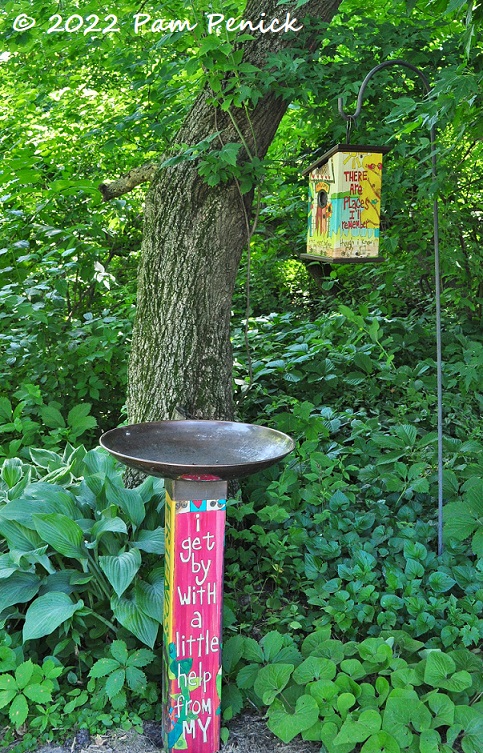
Colorful garden art brightens the shady scene.
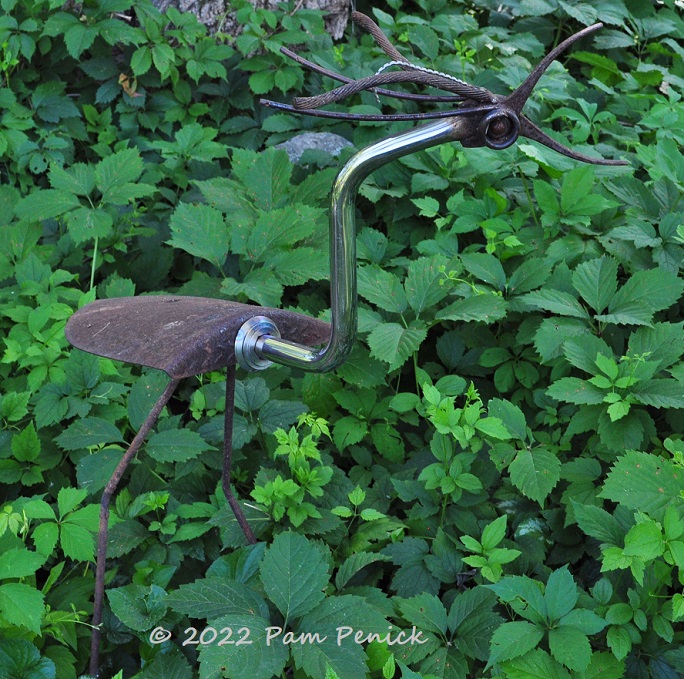
Whimsical found-art pieces, like this bird made from old tools, attract the eye too.
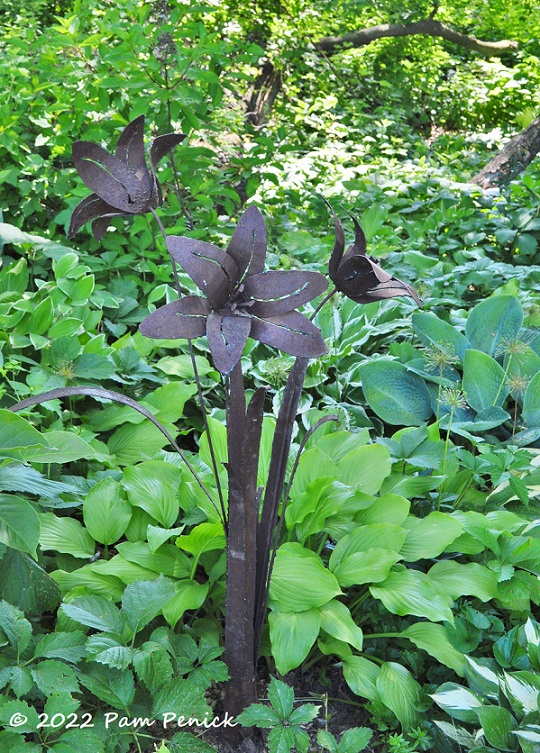
Metal flowers
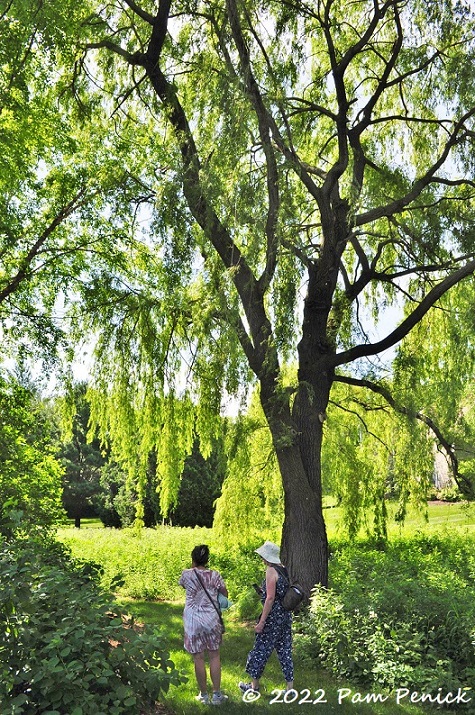
Under a willow
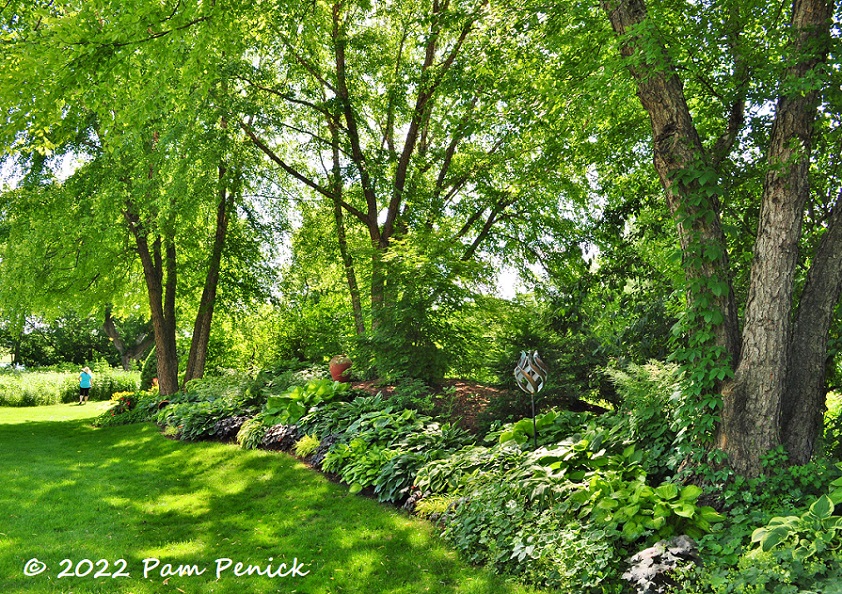
In the side yard, another shade garden with spectacular hostas makes a long, mounded border that screens the neighbors.
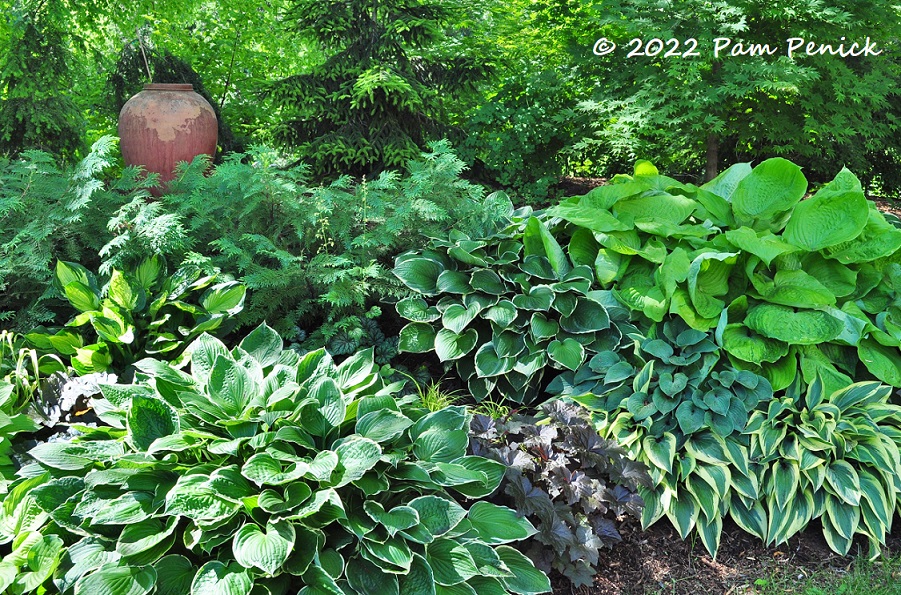
A lovely composition of shades of green and a perfect accent pot
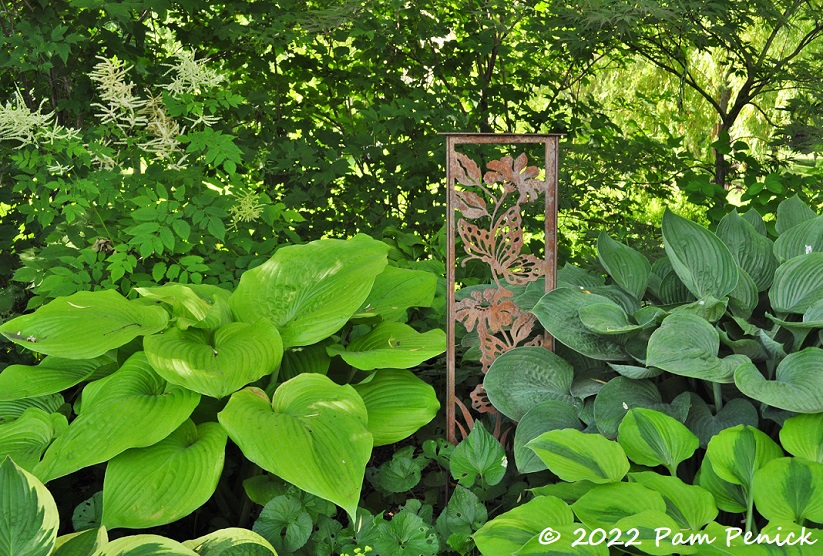
Enormous hostas!
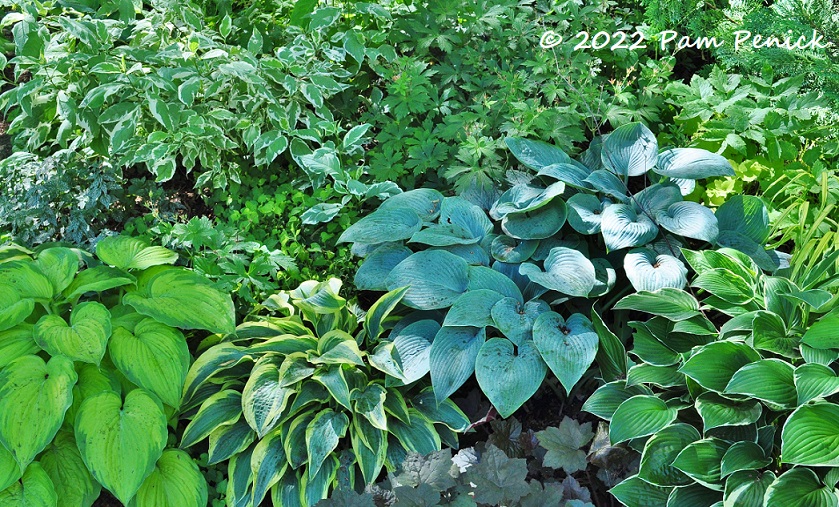
I especially love this blue one.
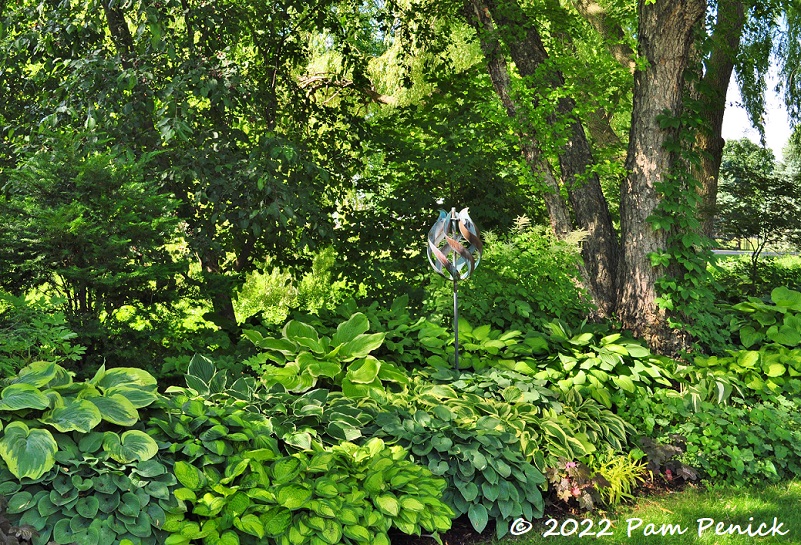
They just go on and on.
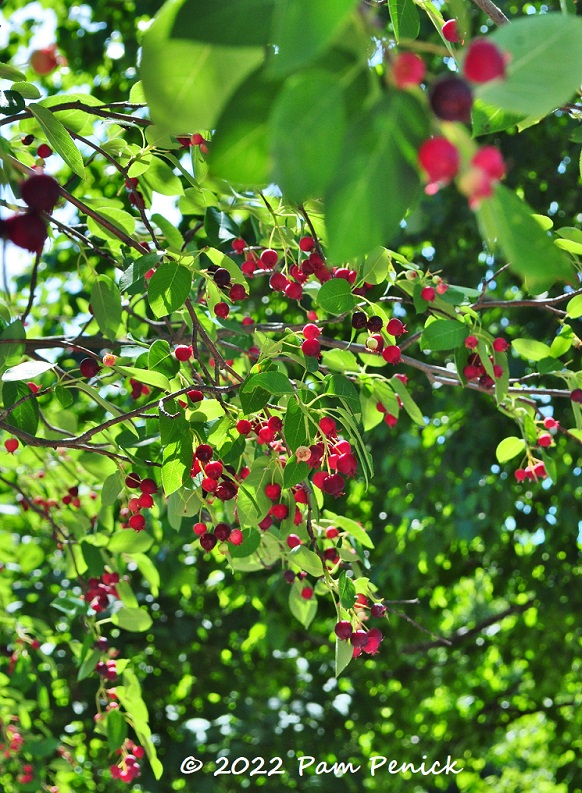
I only had time for a few quick pics in the front garden, including this red-berried tree…
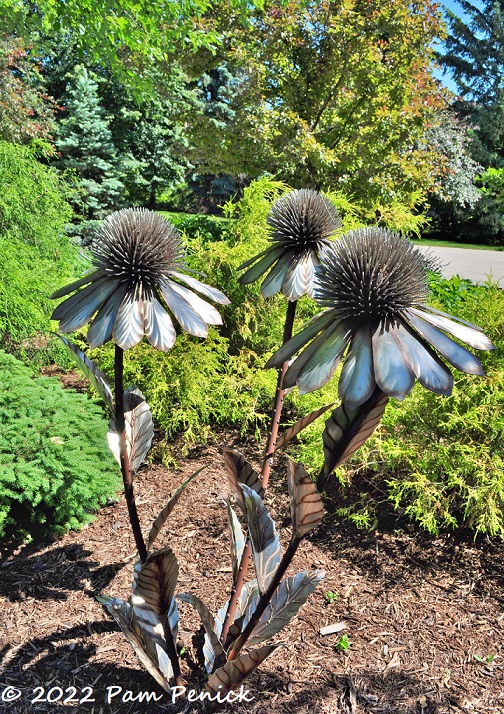
…and a big metal coneflower with bristling cones — a hint, perhaps, of the large-scale prairie garden revealed in the backyard.
Up next: A rare American chestnut at UW Arboretum. For a look back at the Kuster Garden, with its pond and textural shade garden, click here.
__________________________
Digging Deeper
Come learn about gardening and design at Garden Spark! I organize in-person talks by inspiring designers, landscape architects, authors, and gardeners a few times a year in Austin. These are limited-attendance events that sell out quickly, so join the Garden Spark email list to be notified in advance; simply click this link and ask to be added. Season 8 kicks off in fall 2024. Stay tuned for more info!
All material © 2025 by Pam Penick for Digging. Unauthorized reproduction prohibited.


Great description of this amazing property, Pam. I love the fact that she’s made the most of all areas of her garden–shade, prairie, pond, and everything else.
She really has made lovely gardens in all the different shade and sun areas of her large garden.
So many times a garden seems singular—-sunny perennials, dry shade or damp shade, grasses, etc. What I think so fine about this garden is the variety—fine shade garden, sunny pond, prairie wildflower garden. For a garden is the work of a gardener, and I have to believe any gardener would tire of a single theme, no significant variations. I so enjoy your posts.
Thank you, Gaye, and for sharing your excellent observation about this garden.
Ha! Here I was thinking a prairie garden requires no weeding… good thing they get some assistance.
I can never get enough of Hosta, especially when it is combined so expertly to form a stunning carpet. They must not have slugs or snails in Wisconsin. Many of my hosta look like Swiss cheese at this point 😀
I heard that same comment from other gardeners who can grow hosta. Those lucky WI gardeners!
The red-berried tree is a serviceberry, Amelanchier sp., one of my favorite fruits. North America has several native species of it, but sadly none are suitable for the Austin area.
Thanks for the ID, Julia!
Your place is just a dream come true , which vine is growing on your large tree ? I am debating if I want to let Virginia creepers grow in my large silver maple .
Also your pond is just amazing how do you keep your water crystal clear , I am dealing with a lot of string algae I have no filter because it’s for wildlife just 2 aerators I am dealing with so much string algae I am about to throw the towel.
Thanks
Your place is just amazing , what a great habitat for wildlife you are truly providing a safe place for all wildlife .
Brigitte, thanks for your comment on my post about Linda and Phil Grosz’s garden. Your questions would be for Linda to answer, not me, but I hope she will see your comment. Happy gardening to you!